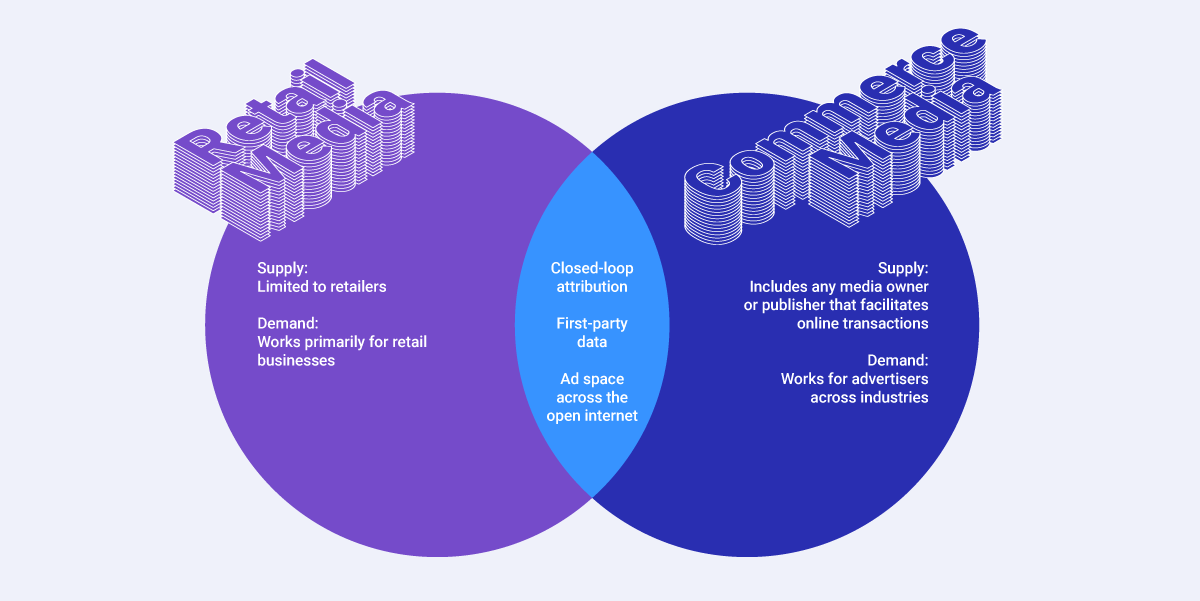Commerce Media vs. Retail Media: Everything You Need to Know

Over the past three years, a wave of economic, cultural, and technological shifts has accelerated the retail industry’s already rapid digital transformation. As emerging ad formats make their way onto the scene, it’s easy for definitions to blend together – such as in the case of commerce media vs. retail media.
Retail media networks, represented by large brands such as Amazon, Walmart, Kroger, Target, and others were the first to gain traction as a means to influence consumers at the point of purchase. But the trend of using first-party data to target shoppers across partner sites isn’t the sole province of major ecommerce names.
Smaller retailers and publishers can use this strategy by tapping into commerce media – an extension of the retail media model that opens new revenue opportunities for media owners across the open internet.
Read on to learn:
- The nuances of commerce media vs. retail media
- Which offering is best suited to different retailers and media owners
- How advertisers can decide which strategy to implement
Commerce Media vs. Retail Media: A Subtle Difference
There is an important distinction for retailers not in the Amazon/Walmart camp. As McKinsey & Co. has noted, retail media is a transformative advertising force that has grown over the past three years as a “harbinger of the commerce media trend.” The consultancy estimates commerce media could drive $1.3 trillion of enterprise value in the US by 2026.
So, if retail media is a subset of a larger industry trend, then what exactly is commerce media? Let’s break down the differences below:
What is Retail Media?
Retail media most commonly refers to ad placements on a retailer’s ecommerce site or app. These ads generate product awareness and influence buying decisions both before and after the shopper clicks the checkout button. In addition to ads served within the retailer’s owned channels, retail media networks enable brands to buy off-site ads across third-party publishers and in-store digital ads, such as product displays and video screens. Retailers tap into their own first-party data to deliver relevant ads to customers based on demographics, shopping habits, buying history, and product SKUs.
What is Commerce Media?
Commerce media widens the scope of retail media. It gives any business or publisher with an ecommerce component new opportunities to engage and monetize their audiences. Commerce media follows the “open internet” concept, allowing brands to serve ads across the whole internet programmatically. While retail media relies on first-party data gathered via the retailer’s website, commerce media augments first-party insights with inputs from other publishers and brand sites. Commerce media also enables retail and non-retail advertisers to use commerce data to engage audiences more effectively throughout the customer journey.

The Key Takeaway: Retailers can’t afford to rely on an online shop alone. Whether tapping into retail media or the broader commerce media trend, there is clear value in running ads that align with their customers’ buying intentions. There’s no reason every ecommerce player shouldn’t be building an ad business to offset notoriously razor-thin profit margins.
Commerce Media vs. Retail Media – Which is the Better Choice for Publishers?
Whether you’re a large legacy retailer or a small publisher with an online store, any business with access to commerce data can stake its claim within the evolving commerce media landscape. Learn which types of companies are best suited to launch retail or commerce media offerings below.
The Best Candidates for Launching a Retail Media Offering
The consensus so far is that any online store that possesses first-party data from millions of daily web visitors has the scale to launch a retail media network. Take drugstore retailer Walgreens, for example. According to Adweek, the brand’s scale is enormous: its network reaches over 9,000 stores and nearly 100 million loyal members. Not many publishers can claim an audience even a fraction of that size.
Building a retail media business is not without certain challenges. The media sales skill set is considerably different from straight ecommerce marketing. Retail brands must be conversant with ad tech and inventory management to realize retail media networks’ fullest value.
Connected retail media platforms from companies such as Criteo help to streamline the buying experience. Integrating with multiple retail media networks, these platforms empower advertisers to scale their retail media buys and optimize performance using just one account.
The Best Candidates for Launching a Commerce Media Offering
While not every business has the scale or resources to launch its own retail media network, there are plenty of opportunities for niche retailers and publishers to capitalize on the growing commerce media trend. Here are a few examples of “media owners” outside the Amazon/Walmart camp that are well-positioned to get into the commerce media game:
Resale Marketplaces
Resale marketplaces are burgeoning hubs for ecommerce. They may include online stores that sell apparel and other physical goods (e.g. Mercari, Depop, Etsy, eBay, Poshmark) or ticketing sites where consumers buy and sell event tickets (e.g. Vivid Seats, StubHub, SeatGeek). Like other retailers, these sites have robust commerce capabilities and sit atop a strong foundation of first-party data.
“Traditional” Publishers
Online publishers aren’t relying solely on affiliate marketing anymore. To supplement traditional ad sales and subscription revenue, publishers like Good Morning America’s Deals & Steals and The Weather Channel’s Shop represent how existing media properties merge commerce and content to create new revenue streams.
Sports Merchandise
Offering access to exclusive content and merchandise, sports organizations draw millions of online visitors even in the offseason. For example, Major League Baseball oversees 30 team websites. It provides streaming video, accompanying online ad placements, and access to all team gift shops. In other words, it has all the makings of a commerce media haven.
Museums
Besides ticket sales, grants, and donations, museums generate 5- to 25% of their annual revenue from online and offline stores. From posters and prints to earrings and t-shirts, museums represent another potentially lucrative commerce media area. As people search for particular artists and shows, museums have an enormous trove of text and visual content to support a range of advertising programs.
Commerce Media vs. Retail Media – Which is the Better Choice for Advertisers?
For most brands, whether they’re major CPG names or niche beauty and personal care companies, the best strategy likely involves using both. However, as marketing channels, retail media and commerce mexia aren’t automatically complementary. A distinct strategy for both is necessary to avoid duplication or cannibalizing ad programs along these different tracks.
Use Cases for Retail Media
Retail media provides targeted reach for brands that sell products on retailers’ websites. Think of it as an opportunity to reach consumers based on purchase history and browsing behavior directly within the ecommerce environment where the product is being sold. Measurable results are a strong suit, as these networks furnish detailed data on ad performance, aiding campaign optimization and providing closed-loop attribution. Furthermore, they offer cost-effectiveness for broad-scale consumer outreach.
Use Cases for Commerce Media
The virtue that comes with commerce media networks is the ability to extend the reach of marketers’ products across diverse publishers and websites, covering all the various stages of a consumer’s purchase path. The access to extensive consumer behavior data allows for more precise ad campaigns. Additionally, these networks grant flexibility in ad formats and targeting options, enabling more engaging campaigns.
A Hybrid Approach
The choice between networks — and how to effectively use them — depends on the primary goal. Retail media networks best suit brands seeking to engage consumers at the point of purchase. For brands interested in reaching consumers at various stages and across multiple platforms, commerce media networks provide reach and flexibility.
Adopting a hybrid retail/commerce media strategy can work on a number of levels. A marketer might use a retail network to target shoppers on a retailer’s website while employing a commerce network to engage those browsing related products on other sites.
What’s Next for Retail, Media, & Advertising?
The connections between online and offline shopping and how advertising reaches consumers changed long ago. But in the last three years, traditional and upstart retailers have adapted to those changes. Understanding the differences, similarities, and values of retail media and commerce media is essential for all brands that want to retain and build their customer bases.
Regardless of their market size or industry vertical, most advertisers can benefit from a combined strategy leveraging the strengths of both retail and commerce media networks. Even as retail media and commerce media become firmly established tools in the online advertising and marketing spaces, there is still room for experimentation. But there’s no question that these two channels will only continue to reshape the consumer journey.
Learn more about Fluent’s commerce media solutions for publishers and advertisers here.